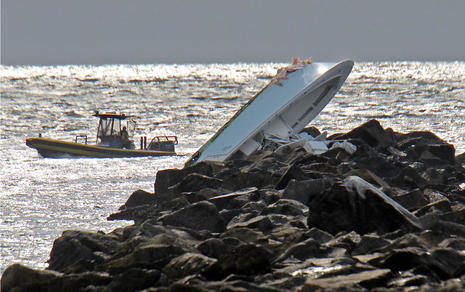Getting Technical: The winding road ahead

Editor’s Note: This column originally appeared in the April issue of Soundings Trade Only as part of my Getting Technical monthly column. covering all things technology. I welcome all feedback on these pieces. Feel free to let me know when you think I’m wrong. I welcome the feedback! Ben S.
One thing is clear about the path to decarbonization in recreational marine: Nobody is sure where we’re going.
At the recent Miami International Boat Show, I saw an overarching theme. In years past, just about the only discussion of environmental sustainability came from electrification. This year, the focus shifted — to something that is, at best, unclear.
I chair this show’s Innovation Awards, which are presented by the National Marine Manufacturers Association. Year after year, we see new electric propulsion products that come with the implicit and explicit claim of greater sustainability. Each year, I hope to find a critical attribute: the ability to compete with the internal combustion engine (ICE). To date, except for very small applications like dinghies, making the case for electric has required external factors, such as no-ICE lakes, a diesel yacht looking to eliminate gasoline-powered tenders, or similar.
This year’s Miami show included a breakfast address from Darren Vaux, president of the International Council of Marine Industry Associations. He talked about ICOMIA’s Pathways to Decarbonization report. It’s a $1 million, two-year study completed by engineering consultancy Ricardo PLC. It focuses on boats smaller than 79 feet, and finds that building boats contributes most of their carbon. The second-largest carbon contribution comes from use during a boat’s life, while about 10% of carbon comes from end-of-life disposal.
The reflex in boating is to compare boats to cars, but because of the great difference in usage patterns, the path toward decarbonization is different. Fully 85% of a passenger car’s carbon footprint comes from usage, compared to just 40% for a boat.
Today’s manufacture of batteries requires a large carbon footprint. As a result, electrically powered vehicles, automobiles or boats start out with a larger carbon footprint. For cars, that deficit can be overcome as the vehicle is driven. Often, the break-even point is 30,000 to 50,000 miles. But boats see much less usage than cars. So, current electric propulsion technology in boats appears unlikely to yield a reduction in a boat’s carbon footprint.
Right about now, you might feel like you’ve been swindled. For years, a move toward electric propulsion has been synonymous with sustainability. But now we are being told that might not be the case.
Especially in boating, we are at the early stages of determining a sustainable path forward. That path simply isn’t known at the start of the journey. Things have to be tried, technologies refined, and, in some cases, dead ends encountered. Are we at a dead end with electrification? I doubt it. But is electric the answer to every sustainability question? Certainly not.
The ICOMIA report concludes that the path forward isn’t singular: “There is no silver bullet. That’s a fact we need to get across to the industry — that this will require a multifaceted approach.”
At this year’s show, Yamaha previewed a hydrogen outboard (pictured above) and fuel system. The company declined to provide specifics about the power output of the engine or the energy storage of the three hydrogen tanks shown on a 26-foot Regulator hull. However, Yamaha did indicate that the prototype system would likely have a range of roughly 50 miles.
If it feels like you’ve been hearing about the sustainability promise of hydrogen power for a long time, that’s probably because you have. General Motors introduced the Chevrolet Electrovan in 1966. In 2002, Honda and Toyota offered fuel-cell vehicles for lease. In the early 21st century, nearly every major automobile manufacturer was developing and, in several cases, selling hydrogen vehicles. But by 2020, all but three had abandoned their programs to focus on battery-powered electric vehicles.
In boating, Yamaha’s hydrogen news preceded another announcement, that the company plans to acquire marine electric propulsion pioneer Torqeedo. It seems that Yamaha’s leadership has taken Pathways to Decarbonization to heart, with multiple avenues of development in play.
The report concludes that for recreational boats, “internal combustion engines powered by renewable liquid fuels are suitable candidates to decarbonize privately owned marine leisure craft. These power systems can provide significant [greenhouse gas] savings, especially for craft with low utilization and long lifetimes, which are highly susceptible to manufacturing and maintenance impacts.”
The report makes clear that the greatest potential impact in the shortest timespan will come from renewable fuels like methanol and isobutanol, and from hybrid electric and ICE powertrains.
Paradoxically, in product announcements and sustainability discussions, we’ve heard the least about these two options. The study emphasizes the limited impact that renewable fuels and hybrid powertrains will have on range, weight and performance. Additionally, renewable fuels have the ability to make an immediate impact on the large base of existing boats. The remainder of the options will only influence newly built boats, whose annual production represents a small percentage of existing boats.
I expect that the Pathways to Decarbonization report will change how little we’ve heard about hybrids and sustainable fuels. Especially for hybrid powertrains, the timing may be nearly perfect, as the world takes a harder look at hybrid propulsion on the road and its potential for a more immediate impact.
And, I look forward to looking back a year from now and recapping the progress made on this issue. I don’t expect we will have finished products or even final answers about the way forward, though. This is a thorny problem, with our industry still exploring ways to make progress.












